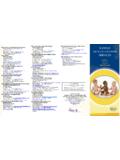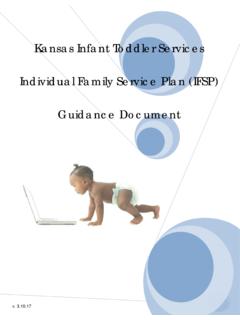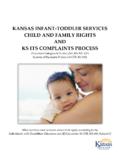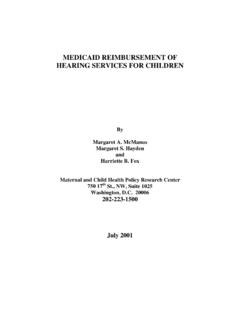Transcription of Kansas - ksits.org
1 Kansas Part C infant /toddler tiny-k hearing Screening Guidelines and Resource Manual Acknowledgements Part C infant /toddler tiny-k hearing Screening Guidelines and Resource Manual is the result of the efforts of people who have been unceasingly dedicated to the early identification and intervention of children with hearing loss. Expertise and time have been generously shared to develop these guidelines. Members of the SoundBeginnings Newborn hearing Screening Program and Part C infant Toddler Services unanimously agreed on the purpose of the guidelines: to provide rationale and process for screening hearing of the birth to three population referred for early intervention in Kansas . The final product provides purpose and direction for the many individuals and groups who value and are involved in the detection and intervention of infants and toddlers in the state of Kansas .
2 A special note of appreciation is given to Liz Abbey, SoundBeginnings Coordinator/Audiologist who guided the development of this document. We thank the many people statewide, including members of the SoundBeginnings Advisory Committee, who reviewed the drafts of the guidelines and provided thoughtful input. Date published: June 1, 2010 Revised December 1, 2014 ii Introduction It is important to identify hearing loss early and provide timely intervention for very young children and their families. Early identification prevents delays, for all hearing loss, mild to profound. Research shows if a child receives early identification before 3 months and intervention before 6 months of age, children with hearing loss have language development that is comparable to peers their age. 2-3 babies per 1,000 births per year in Kansas will be diagnosed with some degree of hearing loss. The purpose of this manual is to provide standardized hearing screening procedures for all Kansas children receiving services through Part C infant /toddler tiny-k services.
3 The target population for screening is all children birth to three years of age in Kansas . Kansas enacted legislation, effective July 1, 1999, to provide screening for the early detection of hearing loss in all babies born in Kansas hospitals. The Kansas Part C infant /toddler tiny-k hearing Screening Guidelines and Resource Manual does not address newborn hearing screening prior to hospital discharge or assessment. The procedures in this document were written to be used as a training manual and a resource for Part C infant /toddler tiny-k networks that screen hearing in children birth to three years of age. After training is completed hearing Screening technicians are then able to conduct hearing screenings and identify children who need further testing. hearing Screening technicians should adhere closely to these procedures and make appropriate referrals to audiologists or physicians when children meet referral criteria to provide the best possible services to their targeted population.
4 Iii Table of Contents Introduction Chapter I hearing SCREENING TECHNICIAN REQUIREMENTS .. 1 A. DEFINITION AND TRAINING REQUIREMENTS .. 1 1. hearing screening technician .. 1 2. KDHE Programs .. 1 a. Sound Beginnings b. infant Toddler Service B. TRAINING .. 1 1. Initial Training .. 2 2. Competencies .. 2 3. Renewal .. 3 Chapter II PREPARATION FOR hearing SCREENING .. 4 A. EQUIPMENT AND SUPPLIES NEEDED .. 4 B. LOCATIONS FOR hearing SCREENING .. 4 C. EQUIPMENT CHECK AND MAINTENANCE .. 4 1. Daily Listening Check .. 5 2. Calibration .. 5 3. Daily Check of Tympanometer .. 5 4. Maintenance of Equipment .. 5 a. Otoscope b. OAE c. Tympanometer D. INFECTION CONTROL AND UNIVERSAL PRECAUTIONS .. 6 1. Contaminant Exposure .. 6 2. Controlling Contaminant Exposure .. 6 3. Disinfecting Tympanometer Probe Tips and Non-Disposable Otoscope Specula .. 6 4. Best Practices for Contaminant Control.
5 6 Chapter III SCREENING PROCEDURES AND PROTOCOLS .. 8 A. PAPER SCREEN .. 8 B. VISUAL INSPECTION .. 9 1. Positioning the Child .. 9 2. Examination Procedure .. 9 3. What Are We Looking For .. 10 4. When to Refer .. 10 C. OTOACOUSTIC EMISSION .. 11 iv 1. Procedure for Conducting OAE Screenings .. 11 2. Poor Test Technique .. 12 3. Noise .. 12 4. Middle Ear Involvement .. 13 5. Obstructions .. 13 6. Cochlear Outer Hair Cell Loss .. 13 D. TYMPANOMETRY SCREENING .. 14 1. Parameters of Tympanometry Screening .. 14 a. Physical Volume b. Compliance 2. Reliability .. 16 3. Procedure for Conducting Tympanometry .. 16 4. Special Considerations .. 18 5. What We Are Looking For .. 18 CHAPTER IV hearing SCREENING PROTOCOLS .. 19 CHAPTER V IMPACT OF hearing LOSS ON INFANTS AND TODDLERS 20 A. IMPACT OF hearing LOSS ON INFANTS AND TODDLERS .. 20 B. OTITIS MEDIA .. 20 C. FREQUENTLY ASKED QUESTIONS.
6 21 APPENDICES OAE hearing SCREENING FORM .. 23 RISK INDICATORS FOR hearing LOSS CHECKLIST .. 24 Spanish Version .. 25 DEVELOPMENTAL SCALES .. 26 Spanish Version .. 27 v Chapter One hearing Screening Technician Requirements A. DEFINITION AND TRAINING REQUIREMENTS 1. hearing Screening Technician is defined as any Part C infant /toddler tiny-k employee trained by a Kansas licensed Audiologist to do hearing screening. The certified technician administers hearing screening tests and an initial screening of the health and function of the ear. The training designates the level of competency. Any person assigned to do hearing screening is required to hold the appropriate training. Any person performing hearing screenings must participate in training in order to maintain the appropriate skills. 2. KDHE Programs a. Sound Beginnings: In 1999, a Kansas law was passed to require hearing screening of all babies born in Kansas hospitals.
7 This document does not address newborn hearing screening. Guidelines for Sound Beginnings, the Newborn hearing Screening Program, may be obtained from KDHE on the Web at b. infant -Toddler Services: Because of the possibility of progressive, late onset, and newly acquired hearing loss, KDHE Part C infant -Toddler tiny-k Services recognizes the need for those providing hearing screening services to be qualified to check the hearing status of infants and toddlers. KDHE Part C infant -Toddler tiny-k requires that any Kansas Part C personnel screening the hearing of an infant or toddler, birth through three years of age, be a licensed audiologist or a hearing Screening Technician trained and retrained following the procedures outlined in this manual. B. TRAINING Any unlicensed person who is assigned to do hearing screening is required to hold the appropriate level of training.* It is strongly encouraged that any person performing hearing screenings participate in training in order to maintain appropriate skills.
8 hearing Screening Technician training should be conducted by a licensed audiologist. The number of participants at trainings should be limited to ensure effective learning environments. Questions regarding training and educational materials can be directed to the Kansas Department of Health and Environment Part C Coordinator or a local audiologist. 1 * NOTE: Licensed persons include those who are licensed, certified, registered, or otherwise recognized by any of the following state agencies: 1. Board of Healing Arts (physicians) 2. Board of Nursing (nurses) 3. Health Occupations Credentialing (speech-language pathologists, audiologists) through the Department of Health and Environment 1. Initial Training Initial training has the following components: Minimum of seven (7) clock hours of instruction. Written test mastery (demonstrated by a minimum score of 80%). Practical skills mastery (demonstrated by a score of 100%).
9 Course evaluation. 2. Competencies Participants in initial training will meet the following competencies: Be able to explain the hearing screening law, the rationale for mandatory hearing screening, and the need for early identification. Be able to describe the basic anatomy and physiology of the ear and common hearing disorders. Exhibit ability to work with children and to explain the hearing screening process. Perform listening check of OAE and determine if OAE is working properly. Be able to determine if environment is satisfactory for performing hearing screening. Be able to identify and explain indicators that place an infant -toddler at risk for hearing loss. Administer the paper screening for risk of hearing loss. Perform visual inspection. Discuss and explain hearing screening results and the need for appropriate follow-up. Record and maintain hearing screening results accurately.
10 Be able to identify unusual or difficult screening situations ( , noise, behavior disturbance) and to report these and any other questions about specific hearing screening results to the audiologist or supervisor/coordinator of the hearing screening program. Be able to explain the purpose and rationale for including tympanometry in screening protocol. 2 Be able to determine measurement parameters used in tympanometry and give a normal range for each. Demonstrate knowledge of symptoms related to various stages of otitis media and possible consequences of otitis media on development and educational progress. Be familiar with other middle ear disorders and current trends in medical care. Demonstrate skill in performing tympanometry and recognizing valid results. Demonstrate application of pass/refer criteria when interpreting tympanograms. Be able to discuss normal auditory development and the use of developmental scales.














